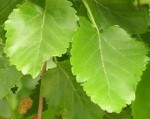 Black mulberry is a slow growing deciduous tree originally from southwestern Asia and a member of the mulberry family that also includes figs, Osage-orange, and banyan. It has wide spreading branches that start close to the ground and forms a open growing, round canopy. With age the plans can develop a gnarled habit that is attractive in the garden. The bark is rough and the dull green leaves are simple, toothed, and 2.5 to 8 inches long by 2 to 4 inches wide. Each leaf is variously lobed and has downy hairs on the lower surface with short stiff hairs on the upper. In spring small separate male and female flowers appear on the same self-fertile plant. In early summer the female flowers produce clusters of edible fruits that are .75 to 1 inch long and mature to dark purple or black. The berries are juicy and sweet, attractive to birds, and are can be used for jam and preserves. Trees would be beautiful shade trees if the berries did not create litter problems including staining sidewalks. A fruitless variety of mulberry (M. alba Kingan) is a better choice. The genus name, Morus, is the classical Latin name for the plant. The specific epithet, nigra, is the classical Latin word for black and refer to the color of the fruit.
Black mulberry is a slow growing deciduous tree originally from southwestern Asia and a member of the mulberry family that also includes figs, Osage-orange, and banyan. It has wide spreading branches that start close to the ground and forms a open growing, round canopy. With age the plans can develop a gnarled habit that is attractive in the garden. The bark is rough and the dull green leaves are simple, toothed, and 2.5 to 8 inches long by 2 to 4 inches wide. Each leaf is variously lobed and has downy hairs on the lower surface with short stiff hairs on the upper. In spring small separate male and female flowers appear on the same self-fertile plant. In early summer the female flowers produce clusters of edible fruits that are .75 to 1 inch long and mature to dark purple or black. The berries are juicy and sweet, attractive to birds, and are can be used for jam and preserves. Trees would be beautiful shade trees if the berries did not create litter problems including staining sidewalks. A fruitless variety of mulberry (M. alba Kingan) is a better choice. The genus name, Morus, is the classical Latin name for the plant. The specific epithet, nigra, is the classical Latin word for black and refer to the color of the fruit.
 Type: Deciduous tree
Type: Deciduous tree
Outstanding Feature: Fruit
Form: Open, round crown
Growth Rate: Slow
Bloom: Small separate male and female flowers appear on the same plant in spring.
Size: 30-40’ H x 35-50’ W
Light: Full sun
Soil: Prefers rich, moist, well-drained soil but tolerates less.
Hardiness: Zones 5-9
Care: Head high when plants are young.
Pests and Diseases: Relatively disease and pest free but susceptible to bacterial leaf spot.
Propagation: Hardwood cuttings, seed with cold stratification
Outstanding Selections:
Morus nigra ‘Chelsea’ (large especially tasty fruit)
Morus nigra ‘Wellington’ (heavy crop of good fruit)